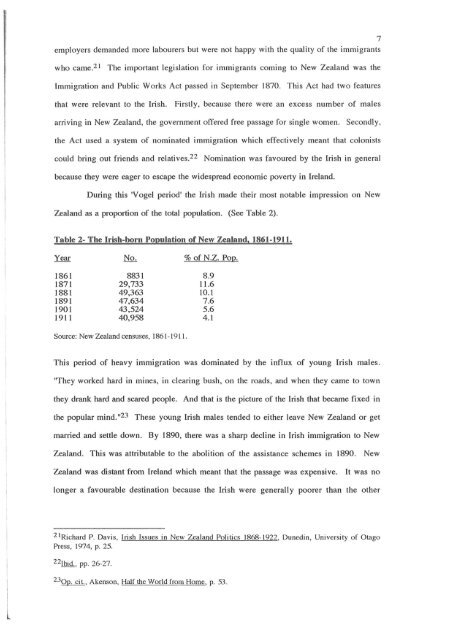TRANSPLANTED IRISH INSTITUTIONS - University of Canterbury
TRANSPLANTED IRISH INSTITUTIONS - University of Canterbury
TRANSPLANTED IRISH INSTITUTIONS - University of Canterbury
You also want an ePaper? Increase the reach of your titles
YUMPU automatically turns print PDFs into web optimized ePapers that Google loves.
7<br />
employers demanded more labourers but were not happy with the quality <strong>of</strong> the immigrants<br />
who came. 21<br />
The important legislation for immigrants coming to New Zealand was the<br />
Immigration and Public Works Act passed in September 1870. This Act had two features<br />
that were relevant to the Irish.<br />
Firstly, because there were an excess number <strong>of</strong> males<br />
arriving in New Zealand, the government <strong>of</strong>fered free passage for single women. Secondly,<br />
the Act used a system <strong>of</strong> nominated immigration which effectively meant that colonists<br />
could bring out friends and relatives. 22 Nomination was favoured by the Irish in general<br />
because they were eager to escape the widespread economic poverty in Ireland.<br />
During this 'Vogel period' the Irish made their most notable impression on New<br />
Zealand as a proportion <strong>of</strong> the total population. (See Table 2).<br />
Table 2- The Irish-born Population <strong>of</strong> New Zealand, 1861-1911.<br />
Year No. % <strong>of</strong> N .Z. Pop.<br />
1861 8831 8.9<br />
1871 29,733 11.6<br />
1881 49,363 10.1<br />
1891 47,634 7.6<br />
1901 43,524 5.6<br />
1911 40,958 4.1<br />
Source: New Zealand censuses, 1861 - 1911.<br />
This period <strong>of</strong> heavy immigration was dominated by the influx <strong>of</strong> young Irish males.<br />
''They worked hard in mines, in clearing bush, on the roads, and when they came to town<br />
they drank hard and scared people. And that is the picture <strong>of</strong> the Irish that became fixed in<br />
the popular mind. oo23<br />
These young Irish males tended to either leave New Zealand or get<br />
married and settle down. By 1890, there was a sharp decline in Irish immigration to New<br />
Zealand. This was attributable to the abolition <strong>of</strong> the assistance schemes in 1890.<br />
New<br />
Zealand was distant from Ireland which meant that the passage was expensive. It was no<br />
longer a favourable destination because the Irish were generally poorer than the other<br />
21Richard P. Davis, Irish Issues in New Zealand Politics 1868-1922, Dunedin, <strong>University</strong> <strong>of</strong> Otago<br />
Press, 1974, p. 25.<br />
22Ibid., pp. 26-27.<br />
l<br />
230p. cit., Akenson, Half the World from Home, p. 53 .
















